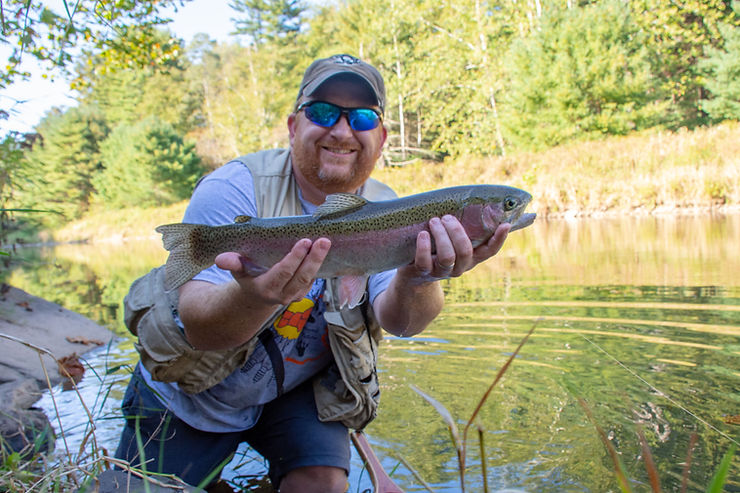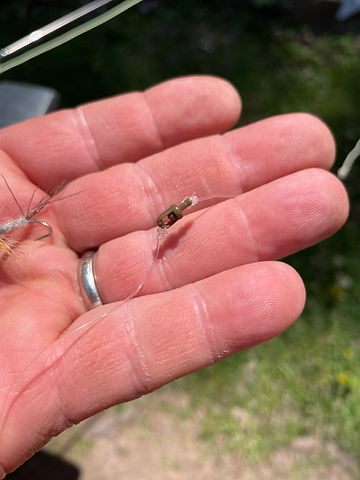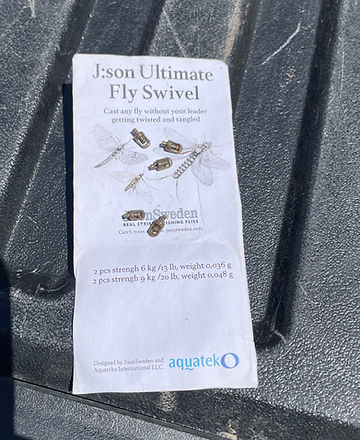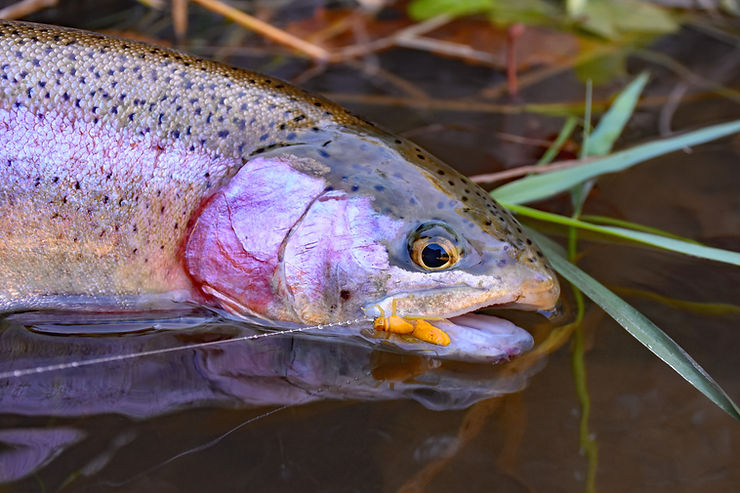Stimulators and Hoppers: The Art of Fishing Big Dry Flies

Fishing with big dry flies is fun. An easy-to-see Stimulator or hopper pattern floating in the current and a long shadow rising up to engulf it. It’s the stuff of dreams.
Fishing big dry flies is not always easy, though. Big dry flies twist the line, are a pain to cast, and require an abundance of patience to fish effectively. In this blog post, we’ll address some of those challenges and provide a few insights into how to catch more fish with big dry flies.
Rods and Leaders
My favorite rod for casting large dries is a 9-foot 6-weight fast action rod. It’s a fairly stiff rod with the power to sling big dry flies on any size water. Any similar 4- or 5-weight fast-action rod will also work.
Also, forget the long, supple leaders used when fishing over size 16 Sulphur hatches. I use fluorocarbon leaders that have the ability to turn over large flies. This is really important because if the fly doesn’t turn over, the fly and tippet will tangle while false casting. At the end of the leader I tie a tippet ring and then attach a two-foot length of nylon tippet.
The style of fishing I’m doing dictates the length and strength of the leader. The typical rule of thumb for tippet selection is to take the size of the fly and divide by 2 or 3. That only applies to fishing big dry flies in certain situations, primarily in high water with heavy current. This time of year, though, with low and clear water the norm, you just cannot fish a size 8 hopper on a 3x or even 4x tippet and expect good results. you’ll get a lot of refusals simply because your tippet creates just enough drag, even if it’s practically invisible to your eye, that fish will refuse it. In these cases, dropping down just one tippet size from “normal” makes a huge difference.
Also don’t forget that larger diameter tippets cast thicker shadows. This doesn’t sound like a major factor until you’re dealing with wary trout in low, clear conditions on a stream that receives a lot of fishing pressure. Will you catch fish? Sure, you’ll catch fish, but not as many as you could with a lighter tippet.
For instance, First Fork Sinnemahoning Creek was so low during the Green Drake hatch this year that I dropped down to 6x tippet (Rio Power Flex). I started out with 5x and caught a few, but when I tied on 6x, I caught fish on almost every cast. And it wasn’t even a heavy hatch and there were not a lot of fish rising. But I did exceptionally well. Not only was the lighter tippet less noticeable, but it also had less impact on the drift of the fly. The result was a more natural presentation that trout couldn’t resist.
Getting Rid of Twist
Big flies are very wind resistant and have a tendency to helicopter during the cast. It can be so severe that the tippet becomes brittle and will break while landing a fish, or sometimes even breaking while false casting. I’ve seen this even with traditional size 12 dry flies. Last week, while using a bushy size 12 Light Cahill on Pine Creek, it took only a handful of casts before my line was so twisted up that I had to cut and re-tie the tippet. Twisting is amplified with even larger flies, such as large hoppers, foam-bodied flies, extended body flies, and other patterns tied on long-shanked hooks.

They look clunky, but a fly swivel makes casting big dry flies a lot easier.
The best way to reduce twist, and actually eliminate it completely, is to use a fly swivel tied in near the butt section of the leader. The best swivel I’ve used to date is the JSon Ultimate Swivel. These swivels are designed for using the ultra-realistic JSon Flies, which are made with sheet-like wings that make even their small flies spin faster than airplane propellers.
The key to using fly swivels effectively is to tie them into the leader right where the butt section starts to taper. It might look ridiculous to have a swivel only about a foot down the leader from the fly line junction, but swivels work best in that position because the line is too limp further down the leader. Further down, the line is too limp to force the swivel bearings to turn. So sure, they look awkward as all heck, but swivels are almost mandatory for fishing big, wind resistant dry flies.
One thing you do have to be aware of, though, is the swivel catching on the top guide of the fly rod. For this reason, I don’t use incredibly long leaders, or I may use a leader and no tippet. But I try to keep the combined length of the leader and tippet (or just leader) to 9-10 feet. This allows me to play a fish within net range without having to pull the swivel through that top guide.

Although there are several brands of fly swivels on the market, the Json Ultimate Fly Swivel is my hands-down favorite.
Casting Big Dry Flies
Big dry flies can be “interesting” to cast until you figure out the timing. For me, that means counting an extra step on each the forward stroke and the backward stroke of the false cast. This will allow enough time for the loop to open up on each end and reduce the potential for that annoying snapping sound that comes with breaking off a fly.
I’m a proponent of backyard (or front yard, if you prefer) casting practice in order to master certain techniques. It’s a good place to get the timing down so that in fishing situations it will seem almost second nature.

Practice casting in the backyard to hone your skills at casting big dry flies.
“God Save the Queen!”
Years ago, I was fishing the Horsefly River in British Columbia with size 4 Chernobyl Ants for huge rainbow trout. My first morning on the river, I missed four consecutive monster trout because I set the hook as soon as I saw them take the fly.
My guide scolded me. “You can’t do that with big dry flies,” he said. “When a trout comes up, you have to say ‘God save the Queen’ before setting the hook. This allows the trout time to get the fly deeper in its mouth before you strike, otherwise the fly will come right out and you’ll miss them.”
In that regard, fishing big dries is similar to fishing very tiny flies. As my friend Doug says, older folks have an advantage when fishing these flies because their reflexes are naturally slower. Well, he’s not wrong!
It’s takes practice and restraint to watch a trout suck in your fly and pause a full second before setting the hook. As with the casting portion of using big dry flies, it takes time and experience to nail down the hook set, and unfortunately, it’s not something you can practice in the yard.
I haven’t always enjoyed using big dry flies such as Stimulators, hoppers, and drakes because I dreaded the constant twisting and technical issues associated with them. However, the right tackle, coupled with a good dose of patience, changed my view. Now I look forward to using big dries, and even more to seeing those beautiful trout rise to greet them.
Did You Enjoy What You Just Read?
Stay up to date with the Dark Skies Fly Fishing monthly newsletter for free and receive the latest posts in fly fishing news, tricks, tips, and techniques, stream reports, as well as updates on new flies added to the Online Store and exclusive discounts!
Sign Up Now

Great article! Very informative!
Thank you for reading!